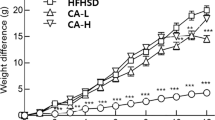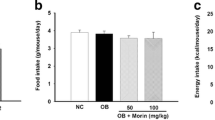Abstract
Purpose
To investigate the effect of cocoa powder supplementation on obesity-related inflammation in high fat (HF)-fed obese mice.
Methods
Male C57BL/6J (n = 126) were fed with either low-fat (LF, 10 % kcal from fat) or HF (60 % kcal from fat) diet for 18 weeks. After 8 weeks, mice from HF group were randomized to HF diet or HF diet supplemented with 8 % cocoa powder (HF–HFC group) for 10 weeks. Blood and tissue samples were collected for biochemical analyses.
Results
Cocoa powder supplementation significantly reduced the rate of body weight gain (15.8 %) and increased fecal lipid content (55.2 %) compared to HF-fed control mice. Further, cocoa supplementation attenuated insulin resistance, as indicated by improved HOMA-IR, and reduced the severity of obesity-related fatty liver disease (decreased plasma alanine aminotransferase and liver triglyceride) compared to HF group. Cocoa supplementation also significantly decreased plasma levels of the pro-inflammatory mediators interleukin-6 (IL-6, 30.4 %), monocyte chemoattractant protein-1 (MCP-1, 25.2 %), and increased adiponectin (33.7 %) compared to HF-fed mice. Expression of pro-inflammatory genes (Il6, Il12b, Nos2, and Emr1) in the stromal vascular fraction (SVF) of the epididymal white adipose tissue (WAT) was significantly reduced (37–56 %) in the cocoa-supplemented mice.
Conclusions
Dietary supplementation with cocoa ameliorates obesity-related inflammation, insulin resistance, and fatty liver disease in HF-fed obese mice, principally through the down-regulation of pro-inflammatory gene expression in WAT. These effects appear to be mediated in part by a modulation of dietary fat absorption and inhibition of macrophage infiltration in WAT.




Similar content being viewed by others
Abbreviations
- ALT:
-
Alanine aminotransferase
- ATM:
-
Adipose tissue-associated macrophage
- DP:
-
Degree of polymerization
- HF:
-
High fat
- HFC:
-
High-fat diet supplemented with 8 % cocoa powder
- HOMA-IR:
-
Homeostasis model assessment of insulin resistance
- IL:
-
Interleukin
- iNOS:
-
Inducible nitric oxide synthase
- LF:
-
Low fat
- MCP-1:
-
Monocyte chemoattractant protein-1
- NO:
-
Nitric oxide
- ORFLD:
-
Obesity-related fatty liver disease
- PAC:
-
Proanthocyanidin
- SVF:
-
Stromal vascular fraction
- TNF-α:
-
Tumor necrosis factor-α
- WAT:
-
White adipose tissue
References
González-Castejón M, Rodriguez-Casado A (2011) Dietary phytochemicals and their potential effects on obesity: a review. Pharmacol Res 64:438–455
Finkelstein EA, Khavjou OA, Thompson H, Trogdon JG, Pan L, Sherry B, Dietz W (2012) Obesity and severe obesity forecasts through 2030. Am J Prev Med 42:563–570
Terra X, Pallarés V, Ardèvol A, Bladé C, Fernández-Larrea J, Pujadas G, Salvadó J, Arola L, Blay M (2011) Modulatory effect of grape-seed procyanidins on local and systemic inflammation in diet-induced obesity rats. J Nutr Biochem 22:380–387
Emanuela F, Grazia M, Marco DR, Maria Paola L, Giorgio F, Marco B (2012) Inflammation as a link between obesity and metabolic syndrome. J Nutr Metab 2012:476380
Wellen KE, Hotamisligil GS (2003) Obesity-induced inflammatory changes in adipose tissue. J Clin Invest 112:1785–1788
Terra X, Montagut G, Bustos M, Llopiz N, Ardèvol A, Bladé C, Fernández-Larrea J, Pujadas G, Salvadó J, Arola L, Blay M (2009) Grape-seed procyanidins prevent low-grade inflammation by modulating cytokine expression in rats fed a high-fat diet. J Nutr Biochem 20:210–218
Kanamoto Y, Yamashita Y, Nanba F, Yoshida T, Tsuda T, Fukuda I, Nakamura-Tsuruta S, Ashida H (2011) A black soybean seed coat extract prevents obesity and glucose intolerance by up-regulating uncoupling proteins and down-regulating inflammatory cytokines in high-fat diet-fed mice. J Agric Food Chem 59:8985–8993
Weisberg SP, Mccann D, Desai M, Rosenbaum M, Leibel RL, Ferrante AW (2003) Obesity is associated with macrophage accumulation in adipose tissue. J Clin Invest 112:1796–1808
Khandekar MJ, Cohen P, Spiegelman BM (2011) Molecular mechanisms of cancer development in obesity. Nat Rev Cancer 11:886–895
Eder K, Baffy N, Falus A (2009) The major inflammatory mediator interleukin-6 and obesity. Inflamm Res 58:727–736
Clément S, Juge-Aubry C, Sgroi A, Conzelmann S, Pazienza V, Pittet-Cuenod B, Meier CA, Negro F (2008) Monocyte chemoattractant protein-1 secreted by adipose tissue induces direct lipid accumulation in hepatocytes. Hepatol 48:799–807
Grassi D, Necozione S, Lippi C, Croce G, Valeri L, Pasqualetti P, Desideri G, Blumberg JB, Ferri C (2005) Cocoa reduces blood pressure and insulin resistance and improves endothelium-dependent vasodilation in hypertensives. Hypertension 46:398–405
Selmi C, Mao TK, Keen CL, Schmitz HH, Gershwin ME (2006) The anti-inflammatory properties of cocoa flavanols. Inflammation 47:163–171
Cooper KA, Donovan JL, Waterhouse AL, Williamson G (2008) Cocoa and health: a decade of research. Br J Nutr 99:1–11
Monagas M, Khan N, Andres-Lacueva C, Casas R, Urpí-Sardà M, Llorach R, Lamuela-Raventós RM, Estruch R (2009) Effect of cocoa powder on the modulation of inflammatory biomarkers in patients at high risk of cardiovascular disease. Am J Clin Nutr 90:1144–1150
Ruzaidi A, Amin I, Nawalyah AG, Hamid M, Faizul HA (2005) The effect of Malaysian cocoa extract on glucose levels and lipid profiles in diabetic rats. J Ethnopharmacol 98:55–60
Matsui N, Ito R, Nishimura E, Yoshikawa M, Kato M, Kamei M, Shibata H, Matsumoto I, Abe K, Hashizume S (2005) Ingested cocoa can prevent high-fat diet-induced obesity by regulating the expression of genes for fatty acid metabolism. Nutrition 21:594–601
Tomaru M, Takano H, Osakabe N, Yasuda A, Inoue K, Yanagisawa R, Ohwatari T, Uematsu H (2007) Dietary supplementation with cacao liquor proanthocyanidins prevents elevation of blood glucose levels in diabetic obese mice. Nutrition 23:351–355
Jalil AMM, Ismail A, Pei CP, Hamid M, Kamaruddin SHS (2008) Effects of cocoa extract on glucometabolism, oxidative stress, and antioxidant enzymes in obese-diabetic (Ob-db) rats. J Agric Food Chem 56:7877–7884
Yamashita Y, Okabe M, Natsume M, Ashida H (2012) Prevention mechanisms of glucose intolerance and obesity by cacao liquor procyanidin extract in high-fat diet-fed C57BL/6 mice. Arch Biochem Biophys 2012:1–10
Mao T, Water JVD, Keen CL, Schmitz HH, Gershwin ME (2000) Cocoa Procyanidins and Human Cytokine Transcription and Secretion. J Nutr 130:2093–2099
Mao TK, Powell J, Water JVD, Keen CL, Schmitz HH, John F, Gershwin ME (2000) The Effect of cocoa procyanidins on the transcription and secretion of interleukin 1beta in peripheral blood mononuclear cells. Life Sci 66:1377–1386
Mao TK, van de Water J, Keen CL, Schmitz HH, Gershwin ME (2002) Modulation of TNF-α secretion in peripheral blood mononuclear cells by cocoa flavanols and procyanidins. Dev Immunol 9:135–141
Ramiro E, Franch A, Castellote C, Pérez-Cano F, Permanyer J, Izquierdo-Pulido M, Castell M (2005) Flavonoids from theobroma cacao down-regulate inflammatory mediators. J Agric Food Chem 53:8506–8511
Kenny TP, Keen CL, Schmitz HH, Gershwin ME, Enny THPK, Een CARLLK, Chmitz HAHS (2007) Immune effects of procyanidin oligomers on peripheral blood mononuclear cells. Exp Biol Med 232:293–300
Gu Y, Hurst WJ, Stuart DA, Lambert JD (2011) Inhibition of key digestive enzymes by cocoa extracts and procyanidins. J Agric Food Chem 59:5305–5311
Kelm MA, Johnson JC, Robbins RJ, Hammerstone JF, Schmitz HH (2006) High-performance liquid chromatography separation and purification of cacao (Theobroma cacao L.) procyanidins according to degree of polymerization using a diol stationary phase. J Agric Food Chem 54:1571–1576
Mlinar B, Marc J, Janez A, Peifer M (2007) Molecular mechanisms of insulin resistance and associated diseases. Clin Chim Acta 375:20–35
Xu H, Barnes GT, Yang Q, Tan G, Yang D, Chou CJ, Sole J, Nichols A, Ross JS, Tartaglia LA, Chen H (2003) Chronic inflammation in fat plays a crucial role in the development of obesity-related insulin resistance. J Clin Invest 112:1821–1830
Lumeng CN, Deyoung SM, Bodzin JL, Saltiel AR (2007) Increased inflammatory properties of adipose tissue macrophages recruited during diet-induced obesity. Diabetes 56:16–23
Trayhurn P, Wood IS (2005) Signalling role of adipose tissue: adipokines and inflammation in obesity. Biochem Soc Trans 33:1078–1081
Grassi D, Lippi C, Necozione S, Desideri G, Ferri C (2005) Short-term administration of dark chocolate is followed by a significant increase in insulin sensitivity and a decrease in blood pressure in healthy persons. Am J Clin Nutr 81:611–614
de Luca C, Olefsky JM (2008) Inflammation and insulin resistance. FEBS Lett 582:97–105
Shoelson SE, Lee J, Goldfine AB (2006) Inflammation and insulin resistance. J Clin Invest 116:1793–1801
Olefsky JM, Glass CK (2010) Macrophages, inflammation, and insulin resistance. Annu Rev Physiol 72:219–246
Clark J, Brancati F, Diehl A (2003) The prevalence and etiology of elevated aminotransferase levels in the United States. Am J Gastroenterol 98:960–967
Schindhelm RK, Diamant M, Dekker JM, Teerlink T, Heine RJ (2006) Alanine aminotransferase as a marker of non-alcoholic fatty liver disease in relation to type 2 diabetes mellitus and cardiovascular disease. Diabetes Metab Res Rev 22:437–443
Buechler C, Wanninger J, Neumeier M (2011) Adiponectin, a key adipokine in obesity related liver diseases. World J Gastroenterol 17:2801–28011
Acknowledgments
The authors would like to acknowledge Dr. Sarah Forester, Ms. Sudathip Sae-tan, Ms. Tongtong Xu, Ms. Ling Tao, Mr. Zachary Bitzer, and Ms. Amy Brownschidle for technical assistance.
Conflict of interest
None.
Author information
Authors and Affiliations
Corresponding author
Electronic supplementary material
Below is the link to the electronic supplementary material.
Rights and permissions
About this article
Cite this article
Gu, Y., Yu, S. & Lambert, J.D. Dietary cocoa ameliorates obesity-related inflammation in high fat-fed mice. Eur J Nutr 53, 149–158 (2014). https://doi.org/10.1007/s00394-013-0510-1
Received:
Accepted:
Published:
Issue Date:
DOI: https://doi.org/10.1007/s00394-013-0510-1




